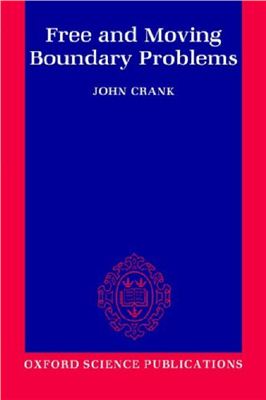New York: Oxford University Press, 1984/
The moving boundaries occur mostly in heat-flow problems with phase changes and in certain diffusion processes. A free boundary does not move but its position has to be determined as part of the solution of a steady-stateproblem. Seepage through porous media is perhaps the most common but by no means the only source of problems of this kind.
The broad spectrum of active research workers includes three groups: engineers and others with practical problems; numerical analysts producing suitable numerical' algorithms; and pure mathematicians who decide that certain problems and their solutions exist, are properly posed, and
may even be unique. They also examine the convergence and stability properties of numerical schemes. A few people fit into all three groups. It is hoped that this book will help to alleviate the usual difficulties of communication_ between the various interested parties.
Both free and moving boundaries have been popular subjects for research in recent years, leading to an almost bewildering collection of new mathematical methods. This seems to be an opportune time to attempt a systematic presentation of them. Authors have tended to test their methods by solving a small number of model problems and so studies of melting ice, simple dams, oxygen diffusion with sorption, and electrochemical machining are referred to frequently in this book. The earliest mathematical work concentrated on one-dimensional problems. Mode computer developments, however, make it possible to handle free and moving boundaries in two and three space dimensions and to model practical systems more realistically. Such methods feature largely in this volume, though it makes no pretence to be a compendium of industrial problems.
Parallel studies of the mathematical properties of the differeatial equations and their solutions, and of the numerical algorithms, have been prolific. It has not been possible here to do more than indicate some of the established results and to' include key references in the extensive
bibliography.
The moving boundaries occur mostly in heat-flow problems with phase changes and in certain diffusion processes. A free boundary does not move but its position has to be determined as part of the solution of a steady-stateproblem. Seepage through porous media is perhaps the most common but by no means the only source of problems of this kind.
The broad spectrum of active research workers includes three groups: engineers and others with practical problems; numerical analysts producing suitable numerical' algorithms; and pure mathematicians who decide that certain problems and their solutions exist, are properly posed, and
may even be unique. They also examine the convergence and stability properties of numerical schemes. A few people fit into all three groups. It is hoped that this book will help to alleviate the usual difficulties of communication_ between the various interested parties.
Both free and moving boundaries have been popular subjects for research in recent years, leading to an almost bewildering collection of new mathematical methods. This seems to be an opportune time to attempt a systematic presentation of them. Authors have tended to test their methods by solving a small number of model problems and so studies of melting ice, simple dams, oxygen diffusion with sorption, and electrochemical machining are referred to frequently in this book. The earliest mathematical work concentrated on one-dimensional problems. Mode computer developments, however, make it possible to handle free and moving boundaries in two and three space dimensions and to model practical systems more realistically. Such methods feature largely in this volume, though it makes no pretence to be a compendium of industrial problems.
Parallel studies of the mathematical properties of the differeatial equations and their solutions, and of the numerical algorithms, have been prolific. It has not been possible here to do more than indicate some of the established results and to' include key references in the extensive
bibliography.

